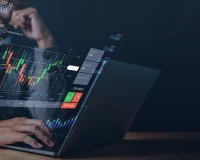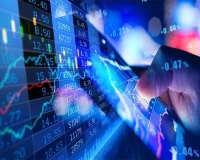-Introduction:
The evolution of technology and its impact on currency trading: artificial intelligence and blockchain technology is an advanced and important topic in the field of financial technology. Artificial intelligence (AI) refers to the ability of computer systems to simulate human intelligence, while blockchain technology is a system that records and stores financial transactions in a secure and decentralized manner. These technologies have significant effects on currency trading
-The Evolution of Currency Trading Technology:
The evolution of currency trading technology can be divided into three main stages:
First Stage: Trading of paper and metal currencies between countries and regions, which began in the Middle Ages and continued until the mid-20th century. In this stage, trading was done physically and directly, and was influenced by the political, social, and cultural factors of each country and region.
Second Stage: Trading of electronic and digital currencies between banks and financial institutions, which began in the 1960s and continued until the beginning of the 21st century. In this stage, trading was done digitally via communication networks and computers, and was influenced by economic, financial, and regulatory factors in each country and region.
Third Stage: Trading of cryptocurrencies and digital currencies among individuals and communities, which began in the first decade of the 21st century and continues to this day. In this stage, trading is done digitally via the internet and smartphones, and is influenced by innovative, technological, and environmental factors affecting each individual and community
-Positive Impacts of Technological Advancement and Its Effect on Currency Trading:
Increased efficiency, speed, transparency, and diversity of trading operations and financial transactions.
Reduced costs, risks, barriers, and intermediaries associated with trading and financial transactions.
Expanded scope, opportunities, and access to global financial markets.
Stimulated innovation, development, and competition in the fields of technology, finance, and the environment
-Negative Impacts of Technological Advancement and Its Effect on Currency Trading:
Increased volatility, inflation, manipulation, and fraud in currency prices, values, and financial transactions.
Reduced oversight, regulation, protection, and security associated with trading and financial transactions.
Worsened disparities, differences, and conflicts between countries, regions, and communities in the fields of economy, finance, and the environment.
Threats to stability, sovereignty, identity, and culture associated with currencies and financial transactions.
-Effects of Adopting Artificial Intelligence in Currency Trading:
- Improved Decision-Making:
AI and machine learning systems can analyze vast amounts of data in real-time, enabling traders to make informed decisions and respond quickly to market changes.
- Enhanced Risk Management:
AI and machine learning can help traders manage risks more effectively by identifying patterns and trends that may indicate potential market shifts.
- Customized Trading Strategies:
AI and machine learning can develop customized trading strategies based on individual traders' preferences and market conditions, leading to more detailed and effective trading plans
-Potential Drawbacks of Using Artificial Intelligence in Currency Trading:
- Ethical Concerns:
The use of AI and machine learning in trading raises ethical questions, as some argue that the technology could be used to exploit market flaws and harm less technologically advanced traders.
- Data Privacy and Security:
The increasing reliance on AI and machine learning systems requires the sharing of large amounts of data, raising concerns about data privacy and security
-Aspects of Benefiting from Artificial Intelligence in Trading:
- Market Trend Analysis:
Artificial intelligence techniques are used to analyze historical and past data to identify recurring market patterns and recognize trends. This is utilized to determine the optimal times to enter or exit trades, which increases the opportunities for profit.
- Keeping Up with and Analyzing Updates:
Economic reports are among the key services provided by the best online trading companies, as the success of trading relies on accurate, clear, and detailed information. AI can be used for this purpose by analyzing articles, economic news, and even social media posts related to the matter.
- Artificial Intelligence and Blockchain Technology:
Artificial intelligence and blockchain technology face technical, ethical, and legal challenges. Technically, there is a need to develop standardized protocols and frameworks to ensure the security, efficiency, and quality of these technologies. Ethically, there is a need to establish boundaries, responsibilities, rights, and duties related to the fair and proper use of these technologies. Legally, there is a need to create laws, regulations, and agreements to govern, monitor, and protect these technologies from manipulation, exploitation, and violations.
AI and blockchain technology offer tremendous opportunities for innovation and improvement across various fields and sectors. Economically, these technologies enable greater efficiency, effectiveness, competitiveness, and growth in industries, commerce, finance, and services. Socially, these technologies help enhance cooperation, communication, solidarity, diversity, and inclusion among individuals, groups, and organizations. Environmentally, they assist in protecting, preserving, and improving natural, biological, and human resources
-The Role of Technology in Risk Mitigation:
Data Analytics: With the help of technology, financial companies can collect and analyze vast amounts of data. This data can be used to identify patterns and trends that can help pinpoint potential risks.
Machine Learning and Artificial Intelligence: Machine learning and AI can assist companies in identifying risks that may not be apparent through traditional analysis. By analyzing large datasets, machine learning algorithms can uncover patterns and relationships that may not be visible to the human eye
-Conclusion:
The development of foreign exchange trading technology has brought significant changes to the way traders interact with the market. From the rise of algorithmic trading to the adoption of artificial intelligence and machine learning, these advancements have empowered traders to make more informed decisions, execute trades with greater precision, and manage risks more effectively. However, these innovations also come with potential drawbacks and challenges, such as ethical concerns, data privacy and security issues, and a lack of transparency in decision-making processes. As technology continues to evolve, it will be crucial for traders, technology providers, and regulators to work together to address these challenges and ensure the industry continues to grow in a responsible and sustainable manner







